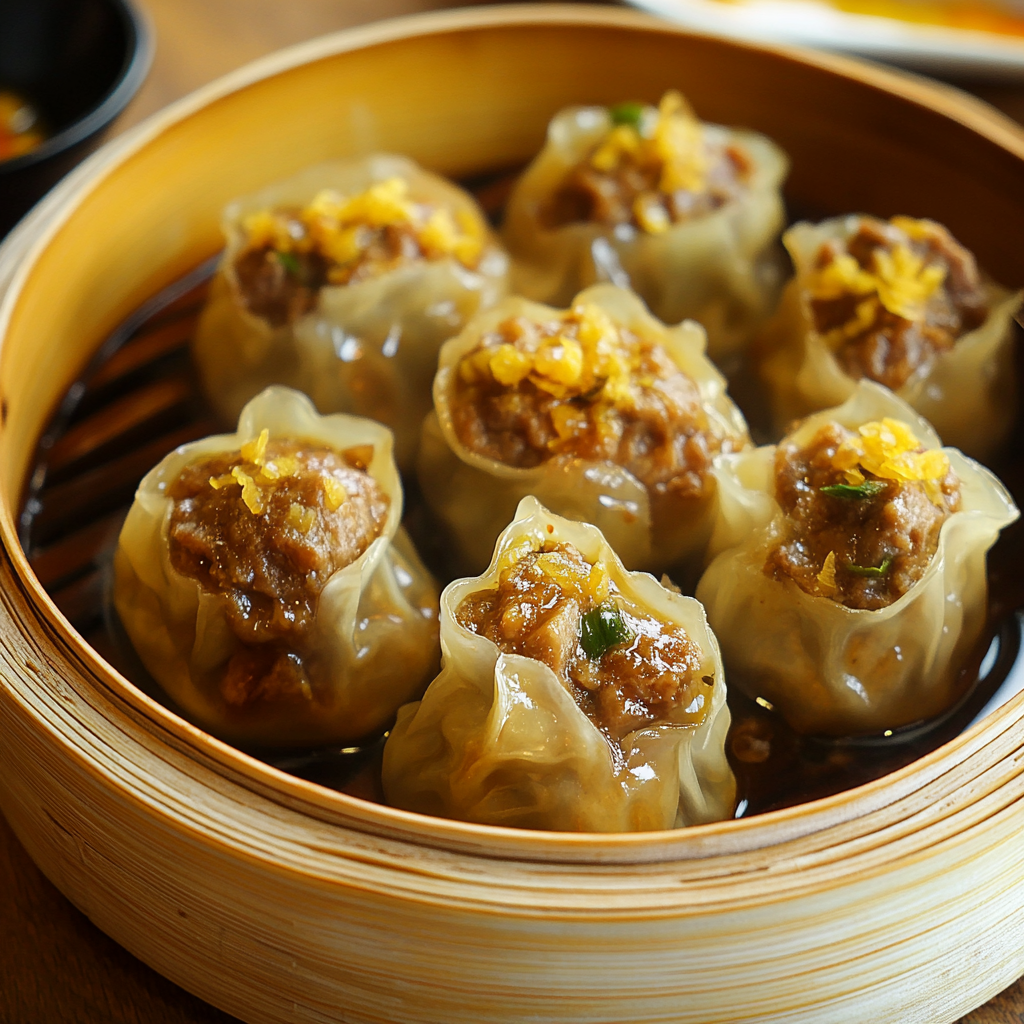Beef Siomai is a classic Filipino dim sum favorite that blends ground beef and shrimp with crunchy water chestnuts, delivering a perfect balance of texture and flavor in every bite. The delicate wonton wrapper gently steams around the juicy filling, making it an irresistible snack or meal option.
This dish is versatile and easy to prepare at home, perfect for casual dinners or festive gatherings. Serve it with a tangy soy-calamansi dipping sauce for an authentic Filipino experience that will surely delight family and friends alike.
Full Recipe
Ingredients:
-
500g ground beef
-
1 cup shrimp, finely chopped
-
1 medium carrot, finely grated
-
1/2 cup water chestnuts, finely chopped
-
1/4 cup green onions, chopped
-
1 egg
-
2 cloves garlic, minced
-
1 tablespoon soy sauce
-
1 tablespoon oyster sauce
-
1 teaspoon sesame oil
-
Salt and pepper to taste
-
Wonton wrappers
Directions:
-
In a large mixing bowl, combine ground beef, chopped shrimp, grated carrot, water chestnuts, and green onions.
-
Add egg, garlic, soy sauce, oyster sauce, sesame oil, salt, and pepper. Mix thoroughly until well combined.
-
Place a wonton wrapper on a flat surface. Spoon about one tablespoon of the mixture onto the center of the wrapper.
-
Gather the edges of the wrapper around the filling and gently press to shape into a siomai dumpling. Repeat with remaining filling and wrappers.
-
Prepare a steamer and line it with parchment paper or cabbage leaves to prevent sticking.
-
Arrange siomai in the steamer, making sure they do not touch each other. Steam for about 15 minutes or until fully cooked.
-
Serve hot with a dipping sauce of soy sauce, calamansi or lemon juice, and chili garlic oil.
Prep Time: 20 minutes | Cooking Time: 15 minutes | Total Time: 35 minutes
Kcal: 180 kcal per serving | Servings: 4 servings
Introduction to Beef Siomai
Beef Siomai is one of the most beloved snacks and appetizers in Filipino cuisine, often enjoyed at street food stalls, family gatherings, and special occasions. This steamed dumpling combines the savory flavors of ground beef with the subtle sweetness of shrimp, enhanced by the crunch of water chestnuts and the fragrant aroma of garlic and green onions. The name “siomai” is derived from the Chinese “shumai,” reflecting the influence of Chinese culinary traditions on Filipino food culture. Despite its simple appearance, beef siomai offers a complex and satisfying combination of textures and tastes, making it a favorite for many.
The Cultural Significance of Siomai in the Philippines
Siomai holds a special place in the heart of Filipino food lovers. Originally introduced through Chinese immigrants, it has been embraced and adapted to local tastes and ingredients. In the Philippines, siomai is commonly sold as street food, often paired with soy sauce, calamansi (a local citrus), and chili garlic oil. It has become more than just a snack — it is a social food that brings people together, whether at home or in bustling city streets.
Its popularity has also led to many variations, including pork siomai, chicken siomai, and even vegetarian options. However, beef siomai remains a classic choice for those who enjoy a rich, hearty filling with just the right amount of bite and moisture. Siomai vendors have also become household names, selling their handmade dumplings from carts or small stalls, making this dish a convenient and delicious go-to for quick meals or snacks.
What Makes Beef Siomai Unique?
What sets beef siomai apart from other dumplings is its harmonious blend of ingredients and textures. The ground beef provides a meaty, juicy base, while the shrimp adds a subtle sweetness and additional texture that elevates the overall flavor. The inclusion of water chestnuts is a key element that adds a pleasant crunch, contrasting with the softness of the meat filling.
The seasoning—usually a combination of soy sauce, oyster sauce, garlic, sesame oil, and green onions—infuses the mixture with layers of savory, umami-rich notes that make every bite flavorful and satisfying. Wrapped in thin wonton wrappers and steamed to tender perfection, beef siomai is a wonderful balance of taste, aroma, and texture.
Why You Should Try Making Beef Siomai at Home
While it’s easy to grab siomai from street vendors or buy frozen versions from the store, making beef siomai at home is a rewarding experience that allows you to customize the flavors and ingredients to your liking. Preparing siomai from scratch gives you control over the quality of meat and freshness of the other components.
Homemade siomai also means you can adjust the seasoning for a milder or bolder flavor, incorporate different vegetables or spices, or even experiment with dipping sauces to find your perfect match. Additionally, making siomai can be a fun group activity — rolling and shaping the dumplings together can bring family and friends closer in the kitchen.
The Health Aspects of Beef Siomai
While siomai is often considered a tasty indulgence, it can be made into a balanced and nutritious dish when prepared mindfully. Using lean ground beef helps reduce the fat content, and the addition of shrimp boosts protein while adding essential nutrients like omega-3 fatty acids.
Water chestnuts contribute fiber and antioxidants, while steaming instead of frying keeps the calorie count lower and preserves more nutrients. For those watching their sodium intake, homemade siomai allows for better control over salt and sauce levels, making it a healthier choice than some commercial or fast-food options.
Tips for Perfect Siomai Every Time
Achieving the perfect siomai texture and flavor requires a few tips and tricks. First, it’s important to finely chop or grind the shrimp and vegetables so they blend seamlessly with the beef and create a uniform filling. Don’t overmix the filling, as this can make the dumplings tough.
When wrapping the siomai, avoid overfilling to prevent the wrappers from tearing during steaming. Using fresh wonton wrappers helps achieve a tender yet sturdy exterior that holds the filling well. Finally, steaming the siomai just until cooked ensures juicy and tender bites, so keep an eye on the timing.
Serving Suggestions and Dipping Sauces
Beef siomai is traditionally served with a dipping sauce made from soy sauce combined with fresh calamansi juice and chili garlic oil, offering a perfect balance of salty, tangy, and spicy flavors. Some variations include vinegar or sweet chili sauce to complement the dumplings.
For a complete meal, beef siomai pairs wonderfully with steamed rice or fried garlic rice and a side of pickled vegetables or fresh salad greens. You can also enjoy it as a snack alongside a warm cup of tea or soda for a classic street food experience.
Variations to Explore
Once comfortable with the classic beef siomai recipe, you might want to try different variations to suit your palate or dietary preferences. For a richer flavor, you could add mushrooms or finely chopped water chestnuts for more crunch. Those who prefer a lighter option can substitute beef with ground chicken or turkey.
For a vegetarian twist, replace the meat with tofu and finely chopped mushrooms or mixed vegetables, seasoned well with soy and sesame oil. You could also experiment with wrapping siomai in different types of wrappers like rice paper or even lettuce leaves for a fresh take.
The Growing Popularity of Siomai Worldwide
Thanks to globalization and the rising interest in Asian cuisine, siomai has found fans outside the Philippines as well. Many Asian restaurants around the world now offer siomai as part of their dim sum or snack menus, often adapting the recipe to local tastes and ingredients.
Filipino food enthusiasts living abroad also appreciate siomai as a nostalgic comfort food, often recreating the recipe at home or seeking out Filipino eateries. This international appeal highlights how simple dishes with authentic flavors can bridge cultures and bring people together through shared culinary experiences.
Conclusion
Beef siomai is much more than a simple steamed dumpling; it’s a symbol of Filipino culinary heritage, a testament to cultural fusion, and a dish full of delightful textures and flavors. Whether enjoyed as a quick snack, a party appetizer, or a comforting homemade meal, it never fails to satisfy.
Making beef siomai at home allows you to appreciate the care and tradition behind each bite while giving you the freedom to customize the recipe according to your taste and health preferences. This versatile dish continues to charm food lovers locally and globally, proving that the simplest foods often make the biggest impact.
If you haven’t tried beef siomai yet, now is the perfect time to bring this flavorful Filipino favorite into your kitchen and share it with family and friends. You’ll discover why it has stood the test of time and continues to be a beloved staple on dining tables everywhere.






